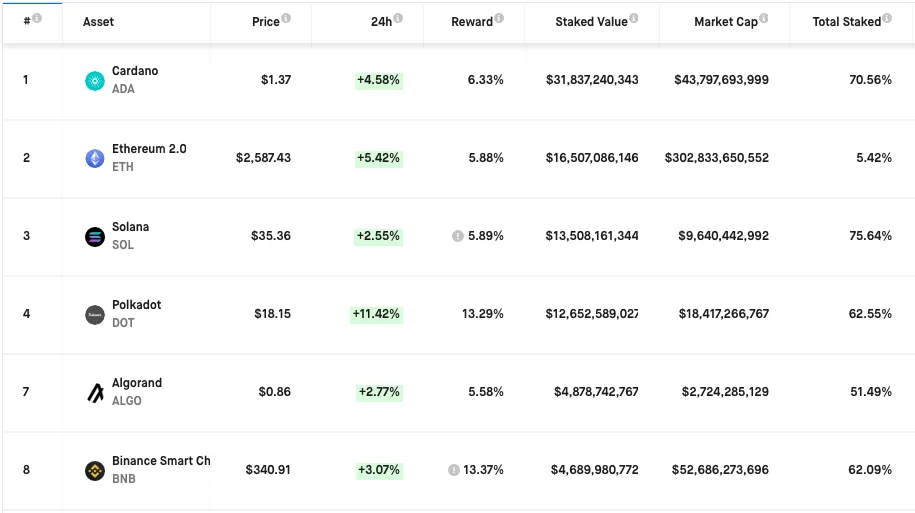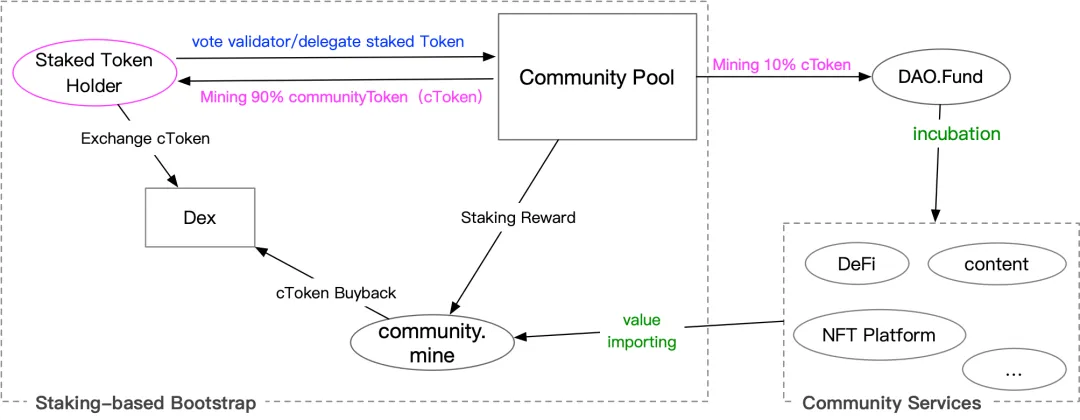Proof-of-Stake has become a popular method to protect decentralized networks. As a result, some new markets and opportunities have also been born out of it.
The Large Scale Staking Economy
In the Proof-of-Stake network, staked asset holders will receive local tokens as compensation (Staking Rewards) as contributors to protecting the security of the decentralized network, and the tokens they receive are proportional to their staked assets.
Currently, well-known networks that use Proof-of-Stake include Ethereum 2.0, Polkadot, Cardano, Solana, Cosmos, Tezos, Tron, and EOS etc. At the time of writing this article, the market value of all PoS networks has exceeded 480 billion U.S. dollars (180 billion U.S. dollars excluding Ethereum), and the total value of staked assets has reached 116.2 billion U.S. dollars. Every year, staked asset holders receive up to 17 billion U.S. dollars in staking rewards, and there are around 19,000 Staking Providers that provide services for them.

However, almost all staking rewards are distributed to the holders of staked assets in the form of local tokens, that is, stake Token A and receive Token A. Under this mechanism, holders of staked assets become financial investors who only look at APY.
Staking Rewards as Incubation Funds for Innovative Projects
Is there a possibility to turn this $17 billion worth of Staking Rewards into incubation funds for innovative projects? If feasible, this will become the source of innovative projects and promote more experiments in the world of blockchain. Crowd-Staking was thereby designed in this context.

Under the Crowd-Staking model, the holders of staked assets vote for community validators or delegate their staked assets to the community. The reward is CommunityToken (cToken) instead of local token, that is, the model here is not the original "Stake Token A and Receive Token A", but "Stake Token A and Receive cToken", which is the token of innovative project.
The local tokens originally to be distributed to the holders of staked assets will enter the community.mine account to repurchase cToken on the open market through contracts or other methods to support the value of cToken.
This model is changed from directly rewarding contributors with staking rewards to instilling the value of staking rewards into cToken and rewarding community members with cToken. This creates a closed loop of positive network effects, allowing community members to unite under a certain community consensus to jointly increase the value of cToken.
In a larger cycle, Community Pool will allocate part of the cToken (such as 10%) to the DAO Fund, and support the development and operation of community services and applications through governance methods such as proposal voting. With the continuous expansion of the network, once the community service generates value, it will be directly allocated into the community.mine account, thereby increasing the repurchase amount of cToken and raising the value of cToken.
This allows a community to launch from scratch, relying on positive network effects to grow continuously. This model also has the following benefits:👇
The security of tokens held by staked asset holders depends on the guarantee of the Proof-of-Stake network consensus and will not be affected by the risks faced by the community;
According to the development of the community and the consideration of the community members, the holders of staked assets can cancel/increase their votes or delegation at any time;
DAO.Fund can be more than just a community fund, it can be diverse in forms, and it can even be used as a development fund in real-world economy;
Compared with the traditional way of providing support for the community (whether it is PoS or Liquidity Mining), it protects the security of community members' assets to the greatest extent, and at the same time provides a channel for them to support innovative projects.
The Realization and Development of Crowd-Staking
Based on this model, Nutbox launched a decentralized staking platform, Peanut, in October 2020. Peanut has become the second largest staked asset delegation platform on Steem Blockchain, with total value of staked assets reaching 4 million U.S. dollars, and the market capitalization of Peanut Token has reached 2 million U.S. dollars.
On Steem Blokchain, the total value of staked assets is only $64 million. In a market with $116.2 billion worth of staked assets, hundreds of communities will be born through the Crowd-Staking model.
Nutbox has modularized Crowd-Staking through the Walnut network, so that anyone can take a similar approach to Peanut to launch a community and promote its development. The entire creation process is as simple as creating a trading pair on Uniswap. What's more, through the Nutbox Walnut network, the community can also create its blockchain-based social media platform and community governance module.

About Nutbox
Nutbox Introduction
DOCS | https://docs.nutbox.io
Webside | https://nutbox.io/
Nutbox Guide
EN|https://blog.nutbox.io/@nutbox.mine/the-new-ui-of-nutbox-is-about-to-online-and-the-tutorial-of-new-ui
CN|https://blog.nutbox.io/@abcallen/wherein-1615536657147-s
Contact US
Wechat: cnsteem
Steem: https://blog.nutbox.io/@nutbox.mine
Discord: https://discord.gg/zPkMuGY
Telegram: https://t.me/joinchat/HKSkL1tns74yODE1
Vote For US
Please vote for our witness nutbox and smt-wherein:
